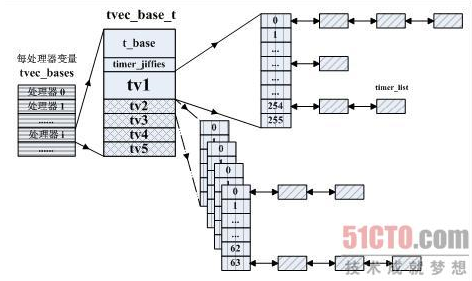Linux设备驱动开发基础--内核定时器
1. Linux内核定时器是内核用来控制在未来某个时间点(基于jiffies)调度执行某个函数的一种机制,其实现位于 <Linux/timer.h> 和 kernel/timer.c 文件中。
2. 被调度的函数是异步执行的,它类似于一种“软件中断”,而且是处于非进程的上下文中,所以调度函数必须遵守以下规则:
(1) 没有 current 指针、不允许访问用户空间。因为没有进程上下文,相关代码和被中断的进程没有任何联系。
(2) 不能执行休眠(或可能引起休眠的函数)和调度。
(3) 任何被访问的数据结构都应该针对并发访问进行保护,以防止竞争条件。
3. Linux内核使用struct timer_list来描述一个定时器
struct timer_list {
struct list_head entry;
unsigned long expires;
void (*function)(unsigned long);
unsigned long data;
struct tvec_base *base;
};
(1)expires:表示期望定时器执行的 jiffies 值,到达该 jiffies 值时,将调用 function 函数,并传递 data 作为参数
(2)entry:连接该定时器到一个内核链表中
(3)base:内核内部使用
4. 定时器使用流程
(1)定义和初始化定时器
① 方法一:
DEFINE_TIMER(timer_name, function_name, expires_value, data);
DEFINE_TIMER为宏定义,源码如下
#define DEFINE_TIMER(_name, _function, _expires, _data) \
struct timer_list _name = \
TIMER_INITIALIZER(_function, _expires, _data)
② 方法二
struct timer_list my_timer;
init_timer(&my_timer);
my_timer.expires = jiffies + delay;
my_timer.data = 0;
my_timer.function = my_function;
注:以上宏和函数定义于include/linux/timer.h。
(3)注册定时器:add_timer
add_timer(&my_timer);
(4)启动定时器:mod_timer
int mod_timer(struct timer_list *timer, unsigned long expires)
注:该函数负责修改内核定时器timer的超时字段expires。该函数可以修改激活和没有激活的内核定时器的超时时间,并把它们都设置为激活状态;返回值为0表示修改的内核定时器在修改之前处于未激活状态,返回值为1表示修改的内核定时器在修改之前处于已激活状态。
(5)删除定时器:一但定时到期,内核会自动删除定时器节点。但有时需要显示的调用函数del_timer()来删除定时器节点
int del_timer(struct timer_list *timer)
5. Linux内核定时器组织架构
(1)与softirq、工作队列两种中断下半部的处理方法类似,每一个内核定时器节点与系统中的处理器通过一个每处理器变量联系起来。内核在文件 kernel/timer.c中使用下面的语句分配了一个名称为tvec_bases、类型为tvec_base_t的每处理器变量。
static DEFINE_PER_CPU(struct tvec_base *, tvec_bases) = &boot_tvec_bases;
(2)数据结结struct tevc_base用来记录系统中每一个处理器上待处理内核定时器节点的相关信息
struct tvec_base {
spinlock_t lock;
struct timer_list *running_timer;
unsigned long timer_jiffies;
struct tvec_root tv1;
struct tvec tv2;
struct tvec tv3;
struct tvec tv4;
struct tvec tv5;
} ____cacheline_aligned;
①lock:用于保护每处理器变量tvec_bases的本地拷贝
②running_timer:记录正在本地处理器上进行超时处理的内核定时器
③timer_jiffies:记录该数据结构中所包含的定时器中最早超时时间,根据该变量可以计算出超时定时器节点所在链表的表头。
④tv1,tv2,tv3,tv4,tv5:
#define TVN_BITS (CONFIG_BASE_SMALL ? 4 : 6)
#define TVR_BITS (CONFIG_BASE_SMALL ? 6 : 8)
#define TVN_SIZE (1 << TVN_BITS)
#define TVR_SIZE (1 << TVR_BITS)
#define TVN_MASK (TVN_SIZE - 1)
#define TVR_MASK (TVR_SIZE - 1) struct tvec {
struct list_head vec[TVN_SIZE];
}; struct tvec_root {
struct list_head vec[TVR_SIZE];
};
(3)内核定时器架构示意图:

5. 简单示例
#include <linux/init.h>
#include <linux/module.h>
#include <linux/moduleparam.h>
#include <linux/time.h>
#include <linux/timer.h>
#include <linux/workqueue.h>
#include <asm/atomic.h> MODULE_LICENSE("GPL"); static struct timer_list timer; static void do_work(struct work_struct* work);
static DECLARE_WORK(test_work, do_work);
static DECLARE_WORK(test_work1, do_work);
static struct workqueue_struct *test_workqueue; // 定时器超时函数
void test_timer_fn(unsigned long arg)
{
if (queue_work(test_workqueue, &test_work)== ) {
printk("Timer (0) add work queue failed\n");
}
} // work func
static void do_work(struct work_struct* work)
{
printk("====do_work start====\n");
printk("====do_work end====\n");
} // init
int wq_init(void)
{
// work queue
test_workqueue = create_singlethread_workqueue("test-wq"); // timer1
init_timer(&timer);
timer.function= test_timer_fn;
add_timer(&timer); //设置超时时间,启动定时器
mod_timer(&timer, jiffies + HZ / ); // 设置超时时间 1\100s return ;
} void wq_exit(void)
{
del_timer(&timer); destroy_workqueue(test_workqueue); printk("wq exit success\n");
} module_init(wq_init);
module_exit(wq_exit);
Linux设备驱动开发基础--内核定时器的更多相关文章
- Linux设备驱动开发基础--阻塞型设备驱动
1. 当一个设备无法立刻满足用户的读写请求时(例如调用read时,设备没有数据提供),驱动程序应当(缺省的)阻塞进程,使它进入等待(睡眠)状态,知道请求可以得到满足. 2. Linux内核等待队列:在 ...
- 转:Linux设备驱动开发(1):内核基础概念
一.linux设备驱动的作用 内核:用于管理软硬件资源,并提供运行环境.如分配4G虚拟空间等. linux设备驱动:是连接硬件和内核之间的桥梁. linux系统按个人理解可按下划分: 应用层:包括PO ...
- 《Linux设备驱动开发具体解释(第3版)》(即《Linux设备驱动开发具体解释:基于最新的Linux 4.0内核》)网购链接
<Linux设备驱动开发具体解释:基于最新的Linux 4.0内核> china-pub spm=a1z10.3-b.w4011-10017777404.30.kvceXB&i ...
- Hasen的linux设备驱动开发学习之旅--时钟
/** * Author:hasen * 參考 :<linux设备驱动开发具体解释> * 简单介绍:android小菜鸟的linux * 设备驱动开发学习之旅 * 主题:时钟 * Date ...
- 《Linux设备驱动开发具体解释(第3版)》进展同步更新
本博实时更新<Linux设备驱动开发具体解释(第3版)>的最新进展. 2015.2.26 差点儿完毕初稿. 本书已经rebase到开发中的Linux 4.0内核,案例多数基于多核CORTE ...
- Linux 设备驱动开发 —— platform设备驱动应用实例解析
前面我们已经学习了platform设备的理论知识Linux 设备驱动开发 —— platform 设备驱动 ,下面将通过一个实例来深入我们的学习. 一.platform 驱动的工作过程 platfor ...
- Linux设备驱动开发环境的搭建(转)
经过两周的摸索,终于对Linux设备驱动开发有了个初步的认识,下面对Linux设备驱动开发环境的搭建做个小结,以方便自己以后查询,同时也能给同道的初学者一点帮助. 刚接触Linux设备驱动时,初学者往 ...
- Linux设备驱动开发详解
Linux设备驱动开发详解 http://download.csdn.net/detail/wuyouzi067/9581380
- 《Linux设备驱动开发详解(第2版)》配套视频登录51cto教育频道
http://edu.51cto.com/course/course_id-379-page-1.html http://edu.51cto.com/course/course_id-379-page ...
随机推荐
- 在Windows 8上安装SQL Server2012
SQL Server 2012 的安装方法跟2008差不多,基本上都是点击下一步,不过在安装的时候可能会进度条一直停留在“正在启动操作系统功能”NetFx3””处不动,出现这个问题的原因是在Windo ...
- Java日志组件logback使用:加载非类路径下的配置文件并设置定时更新
Java日志组件logback使用:加载非类路径下的配置文件并设置定时更新 摘自: https://blog.csdn.net/johnson_moon/article/details/7887449 ...
- eclipse——Maven插件创建java工程
目录结构如下 注意默认JDK为1.5 更改默认JDK 方式一 右键工程 选中JRE1.5 Remove 双击JRE System Library 点击Finish 更改完成 方式二 配置maven ...
- web大文件上传控件-监控f_create流程-Xproer.HttpUploader6
监控f_create流程 1.打开ie,f12 2.启动网络监控 点击开始捕获 上传文件,然后查看监控 将监控信息转到详细视图 向f_create提交的数据 f_create返回值
- 个人项目:wc程序(java)
Github项目地址:https://github.com/jat0824/wc.git 项目相关要求 wc.exe 是一个常见的工具,它能统计文本文件的字符数.单词数和行数.这个项目要求写一个命令行 ...
- [.net 多线程]异步编程模式
.NET中的异步编程 - EAP/APM 从.NET 4.5开始,支持的三种异步编程模式: 基于事件的异步编程设计模式 (EAP,Event-based Asynchronous Pattern) 异 ...
- 怎样检查fragmentation
可以运行下面SQL语句: SELECT dbschemas.[name] AS 'Schema', dbtables.[name] AS 'Table', dbindexes.[name] AS 'I ...
- Android app如何加密?
欢迎访问网易云社区,了解更多网易技术产品运营经验. Android App包含的内容有dex文件,so文件,res,assets资源文件.对应的加密按此内容分为三大方面:dex保护.so加密.资源保护 ...
- javascript正则表达式——元字符
元字符(Metacharacter)是拥有特殊含义的字符: 元字符 描述 (1) . 查找单个字符,除了换行和行结束符. 例子: <!DOCTYPE h ...
- apache-jmeter-3.1的简单压力测试使用方法(下载和安装)
博客转载https://blog.csdn.net/lan_shu/article/details/55190127 压力测试工具LoadRunner是收费的,而且操作复杂.作为开发人员当然是用apa ...
